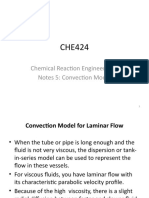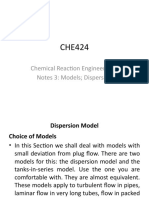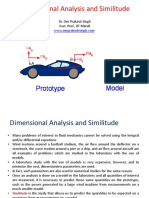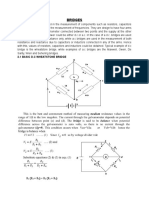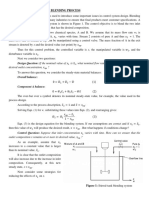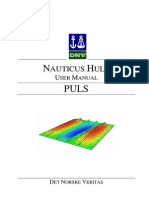0 ratings0% found this document useful (0 votes)
94 viewsChemical Reaction Engineering II Note 2: Flow Models
Chemical Reaction Engineering II Note 2: Flow Models
Uploaded by
Asasira Irad(1) The document discusses different models for representing flows in chemical reactors, ranging from simple plug and mixed flow models to more sophisticated compartment models that divide the reactor into multiple theoretical zones or compartments.
(2) Compartment models can provide a reasonable approximation of real reactor flows by comparing experimental residence time distribution curves to theoretical curves for different compartment combinations.
(3) The document provides examples of how compartment modeling can be used to diagnose issues with assumed plug or mixed flow in a real reactor.
Copyright:
© All Rights Reserved
Available Formats
Download as PPTX, PDF, TXT or read online from Scribd
Chemical Reaction Engineering II Note 2: Flow Models
Chemical Reaction Engineering II Note 2: Flow Models
Uploaded by
Asasira Irad0 ratings0% found this document useful (0 votes)
94 views16 pages(1) The document discusses different models for representing flows in chemical reactors, ranging from simple plug and mixed flow models to more sophisticated compartment models that divide the reactor into multiple theoretical zones or compartments.
(2) Compartment models can provide a reasonable approximation of real reactor flows by comparing experimental residence time distribution curves to theoretical curves for different compartment combinations.
(3) The document provides examples of how compartment modeling can be used to diagnose issues with assumed plug or mixed flow in a real reactor.
Original Title
CHE424-Note 2.pptx
Copyright
© © All Rights Reserved
Available Formats
PPTX, PDF, TXT or read online from Scribd
Share this document
Did you find this document useful?
Is this content inappropriate?
(1) The document discusses different models for representing flows in chemical reactors, ranging from simple plug and mixed flow models to more sophisticated compartment models that divide the reactor into multiple theoretical zones or compartments.
(2) Compartment models can provide a reasonable approximation of real reactor flows by comparing experimental residence time distribution curves to theoretical curves for different compartment combinations.
(3) The document provides examples of how compartment modeling can be used to diagnose issues with assumed plug or mixed flow in a real reactor.
Copyright:
© All Rights Reserved
Available Formats
Download as PPTX, PDF, TXT or read online from Scribd
Download as pptx, pdf, or txt
0 ratings0% found this document useful (0 votes)
94 views16 pagesChemical Reaction Engineering II Note 2: Flow Models
Chemical Reaction Engineering II Note 2: Flow Models
Uploaded by
Asasira Irad(1) The document discusses different models for representing flows in chemical reactors, ranging from simple plug and mixed flow models to more sophisticated compartment models that divide the reactor into multiple theoretical zones or compartments.
(2) Compartment models can provide a reasonable approximation of real reactor flows by comparing experimental residence time distribution curves to theoretical curves for different compartment combinations.
(3) The document provides examples of how compartment modeling can be used to diagnose issues with assumed plug or mixed flow in a real reactor.
Copyright:
© All Rights Reserved
Available Formats
Download as PPTX, PDF, TXT or read online from Scribd
Download as pptx, pdf, or txt
You are on page 1of 16
CHE424
Chemical Reaction Engineering II
Note 2: Flow Models
• Models are useful for representing flows in
real vessels, for scale up, and for diagnosing
poor flow. There are different kinds of models
depending on whether the flow is close to
plug, mixed, or somewhere in between.
• From now on we shall be studying different
models that represent real flows in different
types of reactors.
Compartment Model
• Flow models can be of different levels of
sophistication and the compartment models are the
next stage beyond the simplest, those that assume
the extremes of plug flow and mixed flow. In these
models we consider the vessel and the flow through
it as follows;
• By comparing the E curve for the real vessel
with the theoretical curves for various
combinations of compartments and through
flow, we can find which model best fits the
real vessel. The fit may not be perfect however
but models of this kind are often a reasonable
approximation to the real vessel.
• Various E curves for different combinations of
these models are shown in the figures below.
Figure 1:Various compartment flow models
Figure 1: (cont.)
Figure 1: cont.
Possible Applications
(1) If we know M (kg of tracer introduced in the pulse)
we can make a material balance check. Remember
M = v (area of curve). If we only measure the
output C on an arbitrary scale, we cannot find M
or cannot make this material balance check.
(2) Both V and v must be known in order to be able to
properly evaluate all the elements of a model,
including dead spaces. If we only measure tobs we
cannot find the size of the stagnant regions and we
have to ignore them in the model.
• Therefore;
(3) The semilog plot is a convenient tool for
evaluating the flow parameters of a mixed flow
compartment. Just draw the tracer response
curve on this plot, find the slope and intercept
and this gives the quantities A, B and C shown in
the figure below.
Figure 2: Properties of exponential decay tracer curve
Diagnosing Reactor Ills
• These combined models are useful for
diagnostic purposes to pinpoint faulty flow
and suggest causes. For example, if you expect
plug flow and you know Figure 3 shows
what you could find.
• If you expect mixed flow, Figure 4 shows what
you may find.
Figure 3: Misbehaving Plug flow reactors
Figure 4: Misbehaving mixed flow reactors
Example 1: Behaviour of a gas/liquid contactor
• From the measured pulse tracer response curve
shown in the figure, find the fraction of gas, of
flowing liquid and of stagnant liquid in the gas-
liquid contactor.
• To find Vg, Vl and Vstag, first calculate
from the tracer curves.
tg1 = 8; tg2 = 11 (conc. data)
• Therefore from the figure;
• Therefore;
• In terms of void volume;
You might also like
- Chemical Reaction Engineering II Note 1Document49 pagesChemical Reaction Engineering II Note 1Asasira IradNo ratings yet
- Calculus and Vectors - Chapter 1Document68 pagesCalculus and Vectors - Chapter 1myobNo ratings yet
- Datastructures SyllabusDocument3 pagesDatastructures SyllabussampathaboNo ratings yet
- PDP-11/70 Processor Handbook (1977-1978)Document284 pagesPDP-11/70 Processor Handbook (1977-1978)TheAnonymousLugia100% (1)
- Mazak EIA - Programming Manula For Mazatrol Matrix PDFDocument531 pagesMazak EIA - Programming Manula For Mazatrol Matrix PDFMounir DouggazNo ratings yet
- Chemical Reaction Engineering II Notes 5: Convection ModelDocument30 pagesChemical Reaction Engineering II Notes 5: Convection ModelAsasira IradNo ratings yet
- Gyan CH 14 CreDocument34 pagesGyan CH 14 Crevsneha2514No ratings yet
- Chemical Reaction Engineering II Notes 3: Models DispersionDocument46 pagesChemical Reaction Engineering II Notes 3: Models DispersionAsasira IradNo ratings yet
- Chemical Reaction Engineering II Note 4: Tank-In-Series ModelDocument28 pagesChemical Reaction Engineering II Note 4: Tank-In-Series ModelAsasira IradNo ratings yet
- Ecp 1106304Document9 pagesEcp 1106304boroumandNo ratings yet
- Basics of Non-Ideal FlowDocument32 pagesBasics of Non-Ideal FlowKavali Koteswar ReddyNo ratings yet
- Dimensional Analysis and SimilitudeDocument38 pagesDimensional Analysis and SimilitudeSAURABH JAISWAL 4-Yr B. Tech. Mechanical Engg., IIT (BHU)No ratings yet
- Question Bank EMIDocument5 pagesQuestion Bank EMIharshashetty988No ratings yet
- A Multiple-Winding Magnetics Model Having Directly Measurable ParametersDocument7 pagesA Multiple-Winding Magnetics Model Having Directly Measurable ParametersHoang ManhNo ratings yet
- Real-World Modeling of DistillationDocument12 pagesReal-World Modeling of DistillationGXGGXGNo ratings yet
- Unit-3 Dimensional AnalysisDocument65 pagesUnit-3 Dimensional AnalysisS PrathebaNo ratings yet
- Lecture 2 Non Ideal FlowDocument35 pagesLecture 2 Non Ideal FlowRobinson ANo ratings yet
- Automatic Calibration of The Tank Model L Talonnage Automatique D Un Mod Le CisterneDocument15 pagesAutomatic Calibration of The Tank Model L Talonnage Automatique D Un Mod Le CisterneKim FetalverNo ratings yet
- Instructor Resources: Crystal Violet Colorimetry: A Beer's Law InvestigationDocument10 pagesInstructor Resources: Crystal Violet Colorimetry: A Beer's Law InvestigationmacastillofNo ratings yet
- Arch & Garch ModelDocument22 pagesArch & Garch ModelVarun VaishnavNo ratings yet
- RTD in PFRDocument12 pagesRTD in PFRAmoluck BhatiaNo ratings yet
- Fluid-Fluid Design ReactorDocument33 pagesFluid-Fluid Design ReactorWendell Kim Llaneta100% (1)
- ExamplesDocument13 pagesExamplesyagnikNo ratings yet
- Ratio Error in Current Determination Phase Angle Method For and Transformers A SimpleDocument6 pagesRatio Error in Current Determination Phase Angle Method For and Transformers A SimpleShan MuhammedNo ratings yet
- Lecture 10 - Turbulence Models Applied Computational Fluid DynamicsDocument33 pagesLecture 10 - Turbulence Models Applied Computational Fluid DynamicsprabumnNo ratings yet
- Inductance Leakage CalculationDocument6 pagesInductance Leakage Calculationnuswanggono1994No ratings yet
- Dispersion ModelDocument9 pagesDispersion ModelBrahma Teja LbNo ratings yet
- Constant Stirred Tank Reactor - Technical DefinitionDocument6 pagesConstant Stirred Tank Reactor - Technical DefinitionAnthony RivasNo ratings yet
- G9 Measuring Current and Voltage 2018 AnnotatedDocument5 pagesG9 Measuring Current and Voltage 2018 Annotatedvan080080No ratings yet
- Circulating CurrentDocument6 pagesCirculating CurrentjogiyajeeNo ratings yet
- 2 Physical Mathematical ModelsDocument49 pages2 Physical Mathematical ModelsKabin ThapaNo ratings yet
- Optimization of The Number of Pumping Stations When Tracing Distribution Lines of The External Firefighting Water Supply SystemDocument7 pagesOptimization of The Number of Pumping Stations When Tracing Distribution Lines of The External Firefighting Water Supply SystemMstNo ratings yet
- Eec 235 Bridges-1Document26 pagesEec 235 Bridges-1Plaƴɓoi CartiNo ratings yet
- Comparison of A Networks-of-Zones Fluid Mixing Model For A Baffled Stirred Vessel With Three-Dimensional Electrical Resistance TomographyDocument30 pagesComparison of A Networks-of-Zones Fluid Mixing Model For A Baffled Stirred Vessel With Three-Dimensional Electrical Resistance TomographyGian Carlos Perea DiazNo ratings yet
- B. Tech. Petroleum Engineering: University College of Engineering (A) KakinadaDocument17 pagesB. Tech. Petroleum Engineering: University College of Engineering (A) Kakinada54 Pe AravindswamyNo ratings yet
- Department of Electrical Engineering Electical & Electronics Measurement Question BankDocument4 pagesDepartment of Electrical Engineering Electical & Electronics Measurement Question Bankvijay patilNo ratings yet
- FMM Unit 3 4 TWO MarksDocument6 pagesFMM Unit 3 4 TWO MarksarunjunaiseshanNo ratings yet
- II - Illustrative Example Blending ProcessDocument6 pagesII - Illustrative Example Blending ProcessIshita BhattacharyyaNo ratings yet
- Semester IvDocument7 pagesSemester IvShwet KumarNo ratings yet
- 1-s2.0-S0377042713001350-mainDocument17 pages1-s2.0-S0377042713001350-mainSaraNo ratings yet
- FMHM - EEE - Final Exam Important QuestionsDocument5 pagesFMHM - EEE - Final Exam Important QuestionsBhavani Chandra Unique100% (1)
- LAb Manual For Buckling of Columns LAb Handout Four PDFDocument4 pagesLAb Manual For Buckling of Columns LAb Handout Four PDFakshay deepak rautNo ratings yet
- Butler ManningDocument10 pagesButler ManningAbie BadhurahmanNo ratings yet
- slow learners materials unit 2-3Document13 pagesslow learners materials unit 2-3ArunNo ratings yet
- Modelling and Design Note 02 Tees and WyesDocument6 pagesModelling and Design Note 02 Tees and WyesvshnkrNo ratings yet
- 2013 - The Relationship Between DSGE and VAR ModelsDocument31 pages2013 - The Relationship Between DSGE and VAR Modelsmichael.walkowiakNo ratings yet
- PESC98Document7 pagesPESC98Dafni TorresNo ratings yet
- Experiment 2 - Flow Measurement: Page 1 of 6Document6 pagesExperiment 2 - Flow Measurement: Page 1 of 6fadyaNo ratings yet
- Lecture1423813026 PDFDocument92 pagesLecture1423813026 PDFKarthikeyanKarunNo ratings yet
- SPE 114591 Rate Transient Analysis in Naturally Fractured Shale Gas ReservoirsDocument17 pagesSPE 114591 Rate Transient Analysis in Naturally Fractured Shale Gas ReservoirsIbrahim ElsawyNo ratings yet
- Semester Project:Reservoir SimulationDocument28 pagesSemester Project:Reservoir SimulationRodrigoQueirozNo ratings yet
- BSH 004 2007 - 001 PDFDocument8 pagesBSH 004 2007 - 001 PDFJakesNo ratings yet
- Exampro Gcse Physics p4 ElectricityDocument94 pagesExampro Gcse Physics p4 Electricityforzaplayer100No ratings yet
- Report of Pipe NetworksDocument17 pagesReport of Pipe NetworksJuan Manuel Sanabria GuioNo ratings yet
- Actividad4-Three Circuit Construction Lab Activities PDFDocument12 pagesActividad4-Three Circuit Construction Lab Activities PDFValentina Tascon MontoyaNo ratings yet
- Movement Equations 2: Mathematical and Methodological SupplementsFrom EverandMovement Equations 2: Mathematical and Methodological SupplementsNo ratings yet
- A First Course in Dimensional Analysis: Simplifying Complex Phenomena Using Physical InsightFrom EverandA First Course in Dimensional Analysis: Simplifying Complex Phenomena Using Physical InsightNo ratings yet
- Variational Methods for Boundary Value Problems for Systems of Elliptic EquationsFrom EverandVariational Methods for Boundary Value Problems for Systems of Elliptic EquationsNo ratings yet
- Current Interruption Transients CalculationFrom EverandCurrent Interruption Transients CalculationRating: 4 out of 5 stars4/5 (1)
- Standard-Slope Integration: A New Approach to Numerical IntegrationFrom EverandStandard-Slope Integration: A New Approach to Numerical IntegrationNo ratings yet
- Lecture-3, Practical, 3Document30 pagesLecture-3, Practical, 3Asasira IradNo ratings yet
- Lecture Two: Process DesignDocument67 pagesLecture Two: Process DesignAsasira IradNo ratings yet
- Lecture Three: Process DesignDocument57 pagesLecture Three: Process DesignAsasira IradNo ratings yet
- Che 422: Process Evaluation, Design and Project Management: Lecture OneDocument67 pagesChe 422: Process Evaluation, Design and Project Management: Lecture OneAsasira IradNo ratings yet
- B.CHEM - ENG Edited DAY 2 PDFDocument12 pagesB.CHEM - ENG Edited DAY 2 PDFAsasira IradNo ratings yet
- Validation of Delft3dDocument189 pagesValidation of Delft3dTrieLanyPutriYuliananingrumNo ratings yet
- Nauticus Hull - Steel Plates UnstiffenedDocument90 pagesNauticus Hull - Steel Plates Unstiffenedbosskoj100% (1)
- Cal1 TD6 (2022 23)Document2 pagesCal1 TD6 (2022 23)Chhin HoutNo ratings yet
- Sample Lesson Plan Format Lesson Plan #2 Expectations Are Highlighted in YellowDocument3 pagesSample Lesson Plan Format Lesson Plan #2 Expectations Are Highlighted in Yellowapi-593931076No ratings yet
- Equation of A Tangent To A CircleDocument7 pagesEquation of A Tangent To A CircleMya Thiri LwinNo ratings yet
- Missing Values Analysis & Data Imputation: Single User License. Do Not Copy or PostDocument26 pagesMissing Values Analysis & Data Imputation: Single User License. Do Not Copy or Postmohammed soufiNo ratings yet
- Resumen PythonDocument13 pagesResumen PythonsanabressanabresNo ratings yet
- Northwest Corner MethodDocument8 pagesNorthwest Corner MethodSamatha Farai ZviuyaNo ratings yet
- Quantum Computing: Dirac Representation and Matrix OperationsDocument1 pageQuantum Computing: Dirac Representation and Matrix Operationsyagamilightryuk88No ratings yet
- System DynamicsDocument10 pagesSystem DynamicsahmedNo ratings yet
- Classification of Research QuestionsDocument36 pagesClassification of Research QuestionsM&N ShopNo ratings yet
- Factorial C ProgramDocument7 pagesFactorial C Programbalaji1986No ratings yet
- 0 - Introduction and BasicsDocument104 pages0 - Introduction and BasicsDuy PhướcNo ratings yet
- Combinatorics Graph PDF TheoryDocument2 pagesCombinatorics Graph PDF TheoryNikkiNo ratings yet
- FE NotesDocument189 pagesFE NotesRajib SarkarNo ratings yet
- Researches Regarding Functional Stabilization of Electro-Hydraulic Servo-SystemsDocument4 pagesResearches Regarding Functional Stabilization of Electro-Hydraulic Servo-SystemsMaria Gabriela BusteloNo ratings yet
- Assignment 1Document2 pagesAssignment 1Nguyen Viet Hai (K16HL)No ratings yet
- PH Civil Service Exam 101Document20 pagesPH Civil Service Exam 101Moises Martin Hatulan100% (1)
- Digital Interview QuestionsDocument9 pagesDigital Interview Questionsselvi0412No ratings yet
- PDF MCQS Question Bank No. 3 For TY BBA Subject - Research MethodologyDocument15 pagesPDF MCQS Question Bank No. 3 For TY BBA Subject - Research MethodologyJAGANNATH PRASAD100% (2)
- Listado 74xx SeriesDocument18 pagesListado 74xx SeriesCarlos Andrés Portilla CalderónNo ratings yet
- Chm1 Gasses 1004 FDDocument13 pagesChm1 Gasses 1004 FDaerkn skjksNo ratings yet
- Introduction To Artificial Intelligence and Expert SystemsDocument14 pagesIntroduction To Artificial Intelligence and Expert SystemsCristianBaesuNo ratings yet
- Tyborland C++Document942 pagesTyborland C++daras2684No ratings yet
- U20ma301 Tpde Model Set 1Document4 pagesU20ma301 Tpde Model Set 1PriyankaNo ratings yet
- MT-1004 Linear Algebra NCEAC CS (Modified) Fall 2021Document6 pagesMT-1004 Linear Algebra NCEAC CS (Modified) Fall 2021P200636 Muhammad RafayNo ratings yet
- 2016-06 Rethinking Operational Risk Capital RequirementsDocument42 pages2016-06 Rethinking Operational Risk Capital Requirementsprachi BajpaiNo ratings yet





